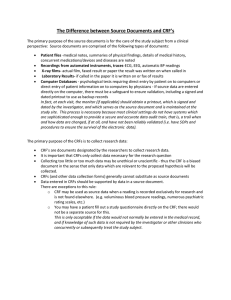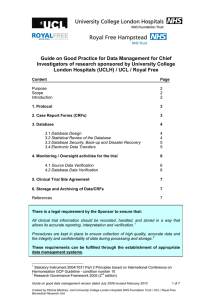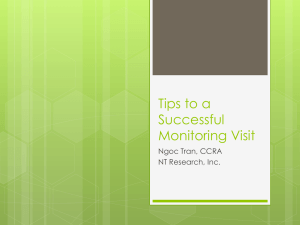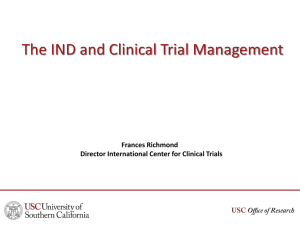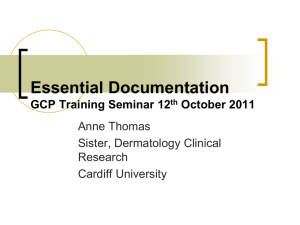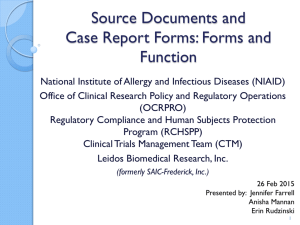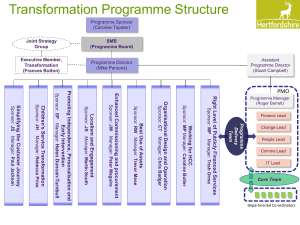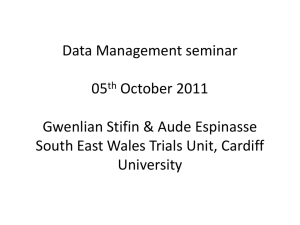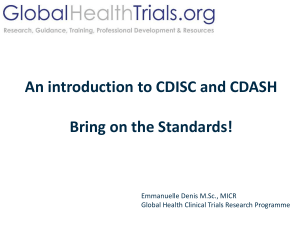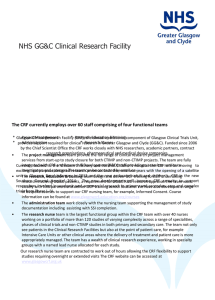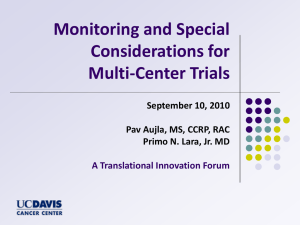Principles of Clinical Data Management
advertisement
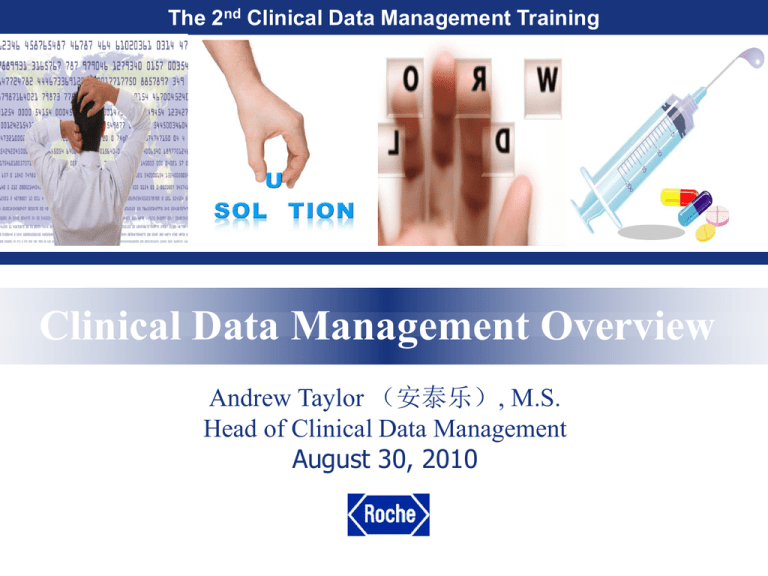
The 2nd Clinical Data Management Training Clinical Data Management Overview Andrew Taylor (安泰乐), M.S. Head of Clinical Data Management August 30, 2010 Learning Objectives Overview of Process Related to Clinical Data Principles of Data Management Data Management Activities Changes Happening Now and in the Future 2 Functions/Roles at Sponsor/CRO Related to Clinical Data Project Leader (leads cross-functional team for each drug project) MD or Clinical Scientist Statistician SAS Programmer Clinical Pharmacokineticist Clinical Research Associate/Monitor Clinical Data Manager Clinical Pharmacovigilence Regulatory Affairs Regulatory Operations Clinical Quality Assurance Medical Writing Information Management/Information Technology 3 Effective Clinical Data Managers Task Competencies Understanding – protocol, documentation, SOPs, regulations, roles and responsibilities Attention to detail; organisational skills e.g. understand instructions Execution of tasks – discrepancy management, data review, UAT, data locking Attention to detail; personal organisation e.g. deliver on time, planning; software skills Effective communication – with study team, monitors, study data manager Good written and verbal communication skills; influence; interpersonal skills Issue identification Attention to detail; problem solving; tenacious Process improvement identification Attention to detail; strategic thinking; displays initiative Examples - variety of available jobs / pathways Statistical Programming Internal Talent Pool Programming Mgr Snr Programmer Programmer External Talent Pool Data Management Clinical Operations Program Data Leader Studies Leader Study Data Manager Data Manager / Programmer Operations Manager Studies Associate Clinical Trial Phases of Drug Development Process (1 of 3) The drug development process requires many resources. Before a new drug is marketed, it must undergo extensive testing and be approved by regulatory agencies in the countries where it will be marketed. Human clinical trials generally consist of four phases, starting on a small scale to assess safety and then expanding to larger trials to test efficacy. Phase I Phase I trials involve testing the drug on a limited number of healthy individuals, typically 20 to 80 people, to determine the drug’s basic safety and pharmacological data. This phase of the drug development process lasts an average of six months to one year. Phase II Phase II trials involve testing a small number of volunteer patients, typically 100 to 200 people who suffer from the targeted disease, to determine the drug’s effectiveness and dose response relationship. This phase of the drug development process lasts an average of one to two years. 6 Clinical Trial Phases of Drug Development Process (2 of 3) Phases IIIa-b Phase IIIa trials involve testing large numbers of patients, typically several hundred to several thousand persons, to verify efficacy on a large scale as well as safety. Phase IIIa trials are focused on regulatory approval issues and involve numerous sites and generally last two to three years. After the successful completion of Phase IIIa, the sponsor of a new drug submits a registration dossier containing all pre-clinical, pharmacologic, efficacy, and safety data; information about the drug’s composition; and the sponsor’s plans for producing, packaging and labeling the drug. The regulatory review process can take up to 30 months or longer, depending on the country, type of drug and other factors. Phase IIIb trials usually begin after submission of the registration dossier and prior to regulatory approval. These studies, which also involve large numbers of patients, generally focus on issues such as the study drug’s cost-effectiveness or its relative efficacy compared with approved drugs in the same therapeutic class or those that are used to treat the same disease. 7 Clinical Trial Phases of Drug Development Process (3 of 3) Phase IV Phase IV trials begin after regulatory approval and typically are used to prove safety and efficacy in new indications (uses); to test new dosage strengths and formulations, e.g., a sustained release capsule or a flavored solution for children; to confirm certain extra clinical benefits such as cost-effectiveness or improved quality of life; and to collect and analyze long-term safety data on patients treated with the drug in normal practice. 8 Overview of Process Related to Clinical Data (1 of 3) Develop Clinical Development Plan for each Drug Project Develop Protocol Select Investigators Develop (e)Case Report Forms (and system) Design and implement Edit Checks Select vendors (e.g., laboratory) and test data interface Train project team Prepare investigator’s site and people 9 Overview of Process Related to Clinical Data (2 of 3) Collect data (in blinded fashion for doubleblind studies) Monitoring Data review and coding Query generation and resolution Merge vendor data, generate more queries Handling of Serious Adverse Events by Sponsor’s Pharmacovigilence personnel Unblinded review by Independent Data Safety Monitoring Board, if needed Quality Assurance Audits by Sponsor 10 Overview of Process Related to Clinical Data (3 of 3) Determine patient acceptability Lock data base then break the blind Deliver to Statisticians/SAS Programmers Finalize database documentation Write clinical study report Create integrated database for safety and efficacy when needed Prepare e-submission CRFs, electronic Case Report Tabulations with documentation for NDA submission 11 Collection of Clinical Data Investigator/staff record observations/data onto source documents Source document: where data is first recorded or a certified copy of that Data is transcribed by Investigator staff onto Case Report Form (CRF) or entered into electronic Case Report Form (eCRF) Vendor data usually transmitted electronically to sponsor database (e.g. lab data) CRF data entered/transferred into sponsor database 12 The Investigator The heart of the clinical trial Sponsor Regulatory Bodies Investigator IRB Site Subjects Vendors 13 Investigator Responsibilities 21 CFR Part 312.62b Investigator must maintain adequate and accurate case histories that record all observations and other data pertinent to the investigation on each individual administered the investigational drug or employed as a control in the investigation. 14 Two Worlds of Clinical Data Management (CDM) Paper world Electronic Data Capture Source data in pt. chart CRFs completed at site and sent to Sponsor Double Data Entry Queries Data Correction Forms (DCFs) record changes Database matches CRF and DCFs 15 Source data in pt. chart Data entered at site with edit checks upon entry Queries Data corrected in system eCRFs created from system Database matches eCRF Difference between e-process and paper process Paper CRF protocol Data entry CRF Electronic data collection protocol Database Data clean Data Analysis Conduct the trial Database/eCRF Data clean Conduct the trial Data entry DB lock DB lock Data Analysis Learning Objectives Overview of Process Related to Clinical Data Principles of Data Management Data Management Activities Changes Happening Now and in the Future 17 Principles of Clinical Data Management (1 of 3) Sponsor database contains all data required in the protocol to document the safety and efficacy of our products Sponsor database matches the (e)CRFs on file in Central Records and includes other data loaded electronically (i.e., lab, ECG, DXA, etc.) Goal is to get data clean and complete according to the data cleaning strategy for each study Comply with relevant laws, regulations and guidelines, including 21 CFR Part 11, HIPAA, GCP, ICH, Guidance on Computerized Systems Used in Clinical Trials, Guidance on electronic submission requirements, CDISC standards for SDTM. 18 Principles of Clinical Data Management (2 of 3) Work to meet project timelines agreed by Clinical Execution Teams and Submission Teams without violating other principles Use Standard Work Processes, follow our Standard Operating Procedures (SOPs) and agree/document exceptions prospectively Make sure data can be readily analyzed and combined across studies within a drug product Use standard data elements, e.g., forms, items, code lists, events, derivations, and procedures. Support the development of drugs/products, not only each protocol, so each protocol for a drug/product is handled in a similar way: same decisions, same data rules/data items/codes where possible/reasonable 19 Principles of Clinical Data Management (3 of 3) Protect the blinding of all personnel involved in study and submission (Privacy) In general new data and/or changes received after the database is unblinded are not included in the clinical database An exception is bioanalytical data that are planned to come in after unblinding. The decision to unlock a database to accept “post finalization data” is made by the clinical execution team and is not taken lightly because it calls into question the integrity of the blinding. Changes should only be made if they alter the primary conclusion of the study, are so numerous that they call into question the quality of the database, or are important new data affecting safety 20 Learning Objectives Overview of Process Related to Clinical Data Principles of Data Management Data Management Activities Changes Happening Now and in the Future 21 Activities of Data Management Study set-up and planning Blinded Review and Coding of Investigator’s Data Load and Review of Vendor Data Database lock activities Database documentation Prepare esub (e)CRFs and datasets for NDA submissions 22 Study Set-Up and Planning Activities Design and implement (e)CRFs using data standards Develop (e)CRF completion guidelines Identify critical variables Establish specifications for edit checks Program and test edit checks Identify and select data vendors (labs, ECG, DEXA, etc.) Set-up and test data exchange with vendors Set-up and validate internal database, if separate Provision sites for EDC, if needed Train users on (e)CRF completion (and EDC) Set-up EDC hotline/help desk, if needed Agree schedule for database lock 23 Final Database Lock Activities Add any data that would unblind the study Merge randomization code to assign treatment groups Flag database records as being locked Deliver database (as SAS datasets) to biostatistics and clinical pharmacokinetics 24 Database Documentation (1 of 2) Data Management Plan Including critical variables Specifications for edit checks Database Documentation Database Validation: User Acceptance Testing Post Production Changes Site instructions for completing (e)CRF Data Entry, for paper study Annotated CRF Data Entry Instructions 25 Database Documentation (2 of 2) Vendor Data Load Specifications Data Load Execution Randomization documentation Quality Control Check Documentation Exceptions to SOPs Database Finalization Critical Variable Summary Interim Analysis Documentation Database Finalization Documentation Database Post Finalization Documentation Post-finalization Data Base Quality Review Audits EDC Helpdesk Documentation Other Database Correspondence 26 Learning Objectives Overview of Process Related to Clinical Data Principles of Data Management Data Management Activities Changes Happening Now and in the Future 27 Changes happening now and in the future (1 of 2) Paper → EDC Electronic Patient Recorded Outcomes (ePROs) PDAs, IVRS, Tablets, Laptops, Web Collection Increase in Technology Patient recruitment Data measurement Data collection Communication Data review Adaptive design studies 28 Changes happening now and in the future (2 of 2) Globalization of Clinical Research Western Europe → Eastern Europe India and Asia South America South Africa Globalization of Submissions New business models Outsourcing Off-shoring Strategic Alliances (preferred providers) Partnership (alliance of 2 pharma companies) 29 The 2nd Clinical Data Management Training Click to edit company slogan .
